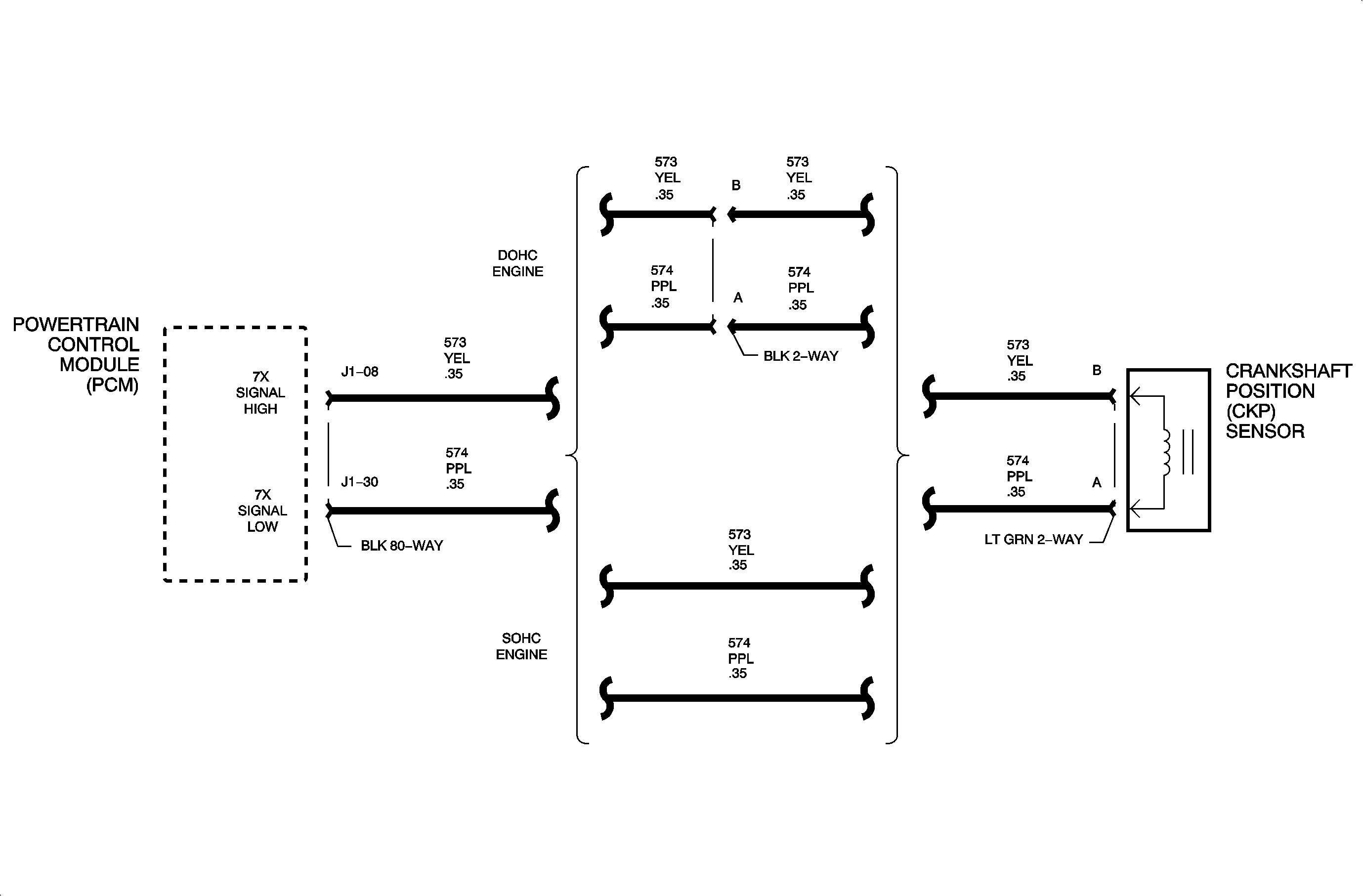
The crankshaft position (CKP) sensor produces an AC voltage of different amplitude and frequency depending on the velocity of the crankshaft. The crankshaft has 7 total machined notches, 6 of which are spaced 60 degrees apart. The remaining tooth is 10 degrees before the #4 cylinder TDC notch. This extra notch is used by the powertrain control module (PCM) to determine the position of the top dead center #4 cylinder necessary to synchronize engine position. The CKP sensor is then used for fuel delivery, spark timing and misfire diagnostics. The PCM must learn the notch variation of crankshaft teeth to perform misfire diagnostics correctly. The crankshaft relearn procedure can be performed on the scan tool or Saturn Service Stall System (SSS) if no current/history misfire counts on any cylinder exist. DTC P1336 sets when the vehicle is driven above a calibrated vehicle speed and the crankshaft variation has not been learned.
DTC Parameters
DTC P1336 will set if the crankshaft position variation has not been learned and vehicle speed is greater than 24 km/h (15 mph).
DTC P1336 diagnostic runs continuously when engine is running with crank learned set to NO.
DTC P1336 is a type A DTC.
Diagnostic Aids
If CRANK LEARNED is set to NO on a scan tool, perform CRANKSHAFT POS. VARIATION LEARN procedure.
If any misfires are active, the PCM will not relearn the crankshaft for that ignition cycle. Diagnose and repair if a misfire exists.
Important: If a crankshaft or PCM has been replaced, the crankshaft MUST be relearned.
Any misfire related DTCs will cause the PCM not to learn the crankshaft. These are listed in the DTC P0300 facing page. Diagnose those DTCs first.
Crankshaft Position Variation Learn Procedure
- Start the engine.
- Using a scan tool, monitor MISFIRE CURRENT and HISTORY CYLS #1-4 to make sure no misfires exist. Correct a misfire condition if one exists.
- Using a scan tool or SSS, perform the CRANKSHAFT POS. VARIATION LEARN procedure.
- When the SERVICE telltale flashes, accelerate engine, with accelerator pedal, to 3,500 RPM. The PCM will take 2 engine revolutions to learn the crankshaft notch variation.
Notice: The PCM will not learn the crankshaft if a mistake is present.
Crankshaft Position Variation Procedure Explained
Important: If vehicle speed is present or if the throttle position (TP) angle is greater than 2.3 percent when CRANK LEARNED adaptive is NO, the delay counter will increment and the ignition will have been cycled OFF for 10 seconds to reset the counter. The entire procedure will have to be repeated.
When the procedure is initiated, the scan tool will send a message to the PCM to reset the CRANK LEARNED adaptive to NO. After this is accomplished, a delay counter in the PCM will remain constant until all of the misfire criteria has been met or MISFIRE ENABLED is set to YES on the scan tool.
Misfire Enable Criteria
| • | The engine run time is greater than 20 seconds, only when CRANK LEARNED is set to NO. |
| • | The engine speed is between 562-5,500 RPM. |
| • | The engine coolant temperature (ECT) is greater than -7°C (20°F). If the ECT is less than -7°C (20°F), the PCM will wait until the ECT is greater than 20°C (68°F). |
| • | The ignition voltage is between 8-18 volts. |
| • | The fuel level is greater than 3.8 L (1 gallon). |
| • | No 5-volt reference, camshaft (CAM), CKP, ECT, fuel trim, idle air control (IAC) valve, intake air temperature (IAT), manifold absolute pressure (MAP), throttle position (TP) or vehicle speed DTCs have been set |
As soon as MISFIRE ENABLED equals YES when CRANKSHAFT LEARNED equals NO, no misfires can exist. The PCM will then start to decrement the delay counter down to zero, which will take 2 engine revolutions. Once the delay counter is at zero, a 400 revolution test at idle is performed to determine if the engine idle is stable enough to perform the relearn procedure. At this time the PCM determines if any misfires are present.
Important: If one misfire occurs during the 2+400 revolution test, the PCM will not learn the crankshaft for that ignition cycle. The ignition will have to be turned OFF for 10 seconds and the entire procedure repeated.
Important: When monitoring misfires, use a scan tool to monitor MISFIRE CURRENT CYLS. #1-4 and MISFIRE HISTORY CYLS. #1-4. The current misfire counters will update to the history counters every 200 revolutions and the current counters will be reset to zero. The history counters are reset to zero every ignition cycle unless P0300 is active.
After the PCM has run the 2+400 revolution test without any misfires, the SERVICE telltale will flash. The PCM will then wait for the engine RPM to be raised between 3,000-4,000 RPM. The PCM will then take 2 crankshaft revolutions to learn the crankshaft variation. The procedure is now completed.
